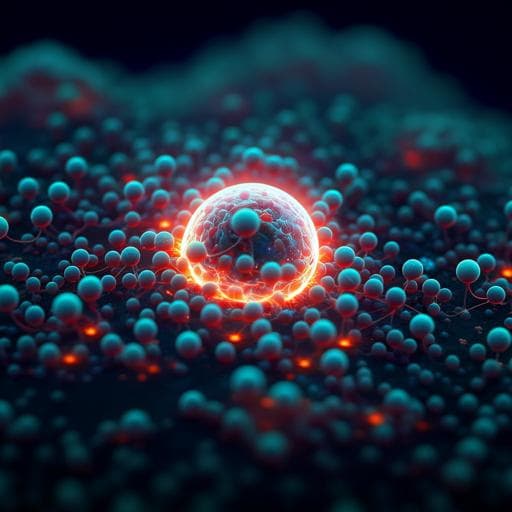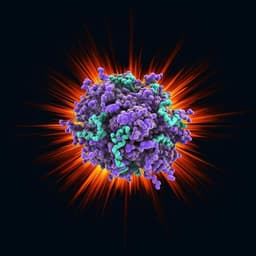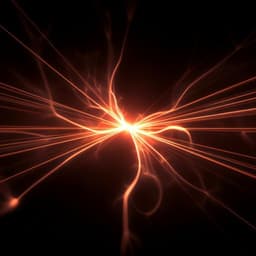
Chemistry
Observation of molecular resonant double-core excitation driven by intense X-ray pulses
E. Pelimanni, A. E. A. Fouda, et al.
Discover groundbreaking research on a resonant double-core excitation scheme in N2, where two core-level electrons are promoted to molecular orbitals by a high-energy XFEL pulse. This innovative approach reveals new avenues for chemical analysis and observing ultrafast dynamics, as shown by Eetu Pelimanni and his colleagues.
~3 min • Beginner • English
Introduction
The study investigates whether intense, few-femtosecond, broad-bandwidth XFEL pulses can resonantly and sequentially excite two core-level electrons in a molecule, thereby creating neutral two-site double core hole (ts-DCH) states with high cross section and selectivity. Building on the high state- and site-selectivity of resonant X-ray interactions, the work aims to extend single-photon XAS concepts to multidimensional resonant excitations and to benchmark theoretical descriptions of nonlinear X-ray processes. The test system is N₂, where selection rules and symmetry considerations restrict accessible DCH configurations. Because sequential resonant excitations shift resonance energies only by a few eV (unlike core ionization thresholds), a typical SASE XFEL bandwidth can span both steps, enabling a single-pulse double-core excitation. The authors hypothesize and then demonstrate that two 1σg electrons can be resonantly promoted to the degenerate 1πg orbitals, forming a neutral ts-DCH that decays via characteristic participator channels (DCH-PP and DCH-SP) detectable in electron spectra. The work is important for enabling selective creation and probing of exotic multi-core-hole configurations, for advancing nonlinear X-ray spectroscopy, and for informing theoretical treatments of nonlinear X-ray–matter interactions.
Literature Review
The paper situates the work within: (i) established resonant X-ray methods (XANES, resonant electron/ion spectroscopies, RIXS, anomalous scattering) typically operating in the weak-field regime; (ii) nonlinear XFEL-enabled phenomena (coherent core-excitation, stimulated emission and Raman scattering, Rabi oscillations, and enhanced ultrafast diffraction via transient resonances); (iii) multi-photon X-ray interactions including multi-core ionization and hidden resonances, and two-photon double excitations realized in rare-gas clusters and dimers in the XUV. Prior theory suggested small energy shifts (few eV) between sequential resonances from different atomic sites in small molecules, implying a single SASE pulse can span both resonances. Theoretical classification of DCH states in homonuclear diatomics (Cederbaum et al.) limits the accessible double-core configurations by parity and energy; ss-DCH requires much higher energy (~60 eV shift) and is excluded, favoring ts-DCH when both steps lie within the SASE bandwidth. The work responds to calls for benchmark nonlinear X-ray data in small molecules to validate modeling approaches.
Methodology
The study combines ab initio electronic-structure and decay-rate calculations with angle-resolved electron time-of-flight (TOF) spectroscopy at the SASE3 soft X-ray branch of the European XFEL.
- Theory and spectra simulation:
- Electronic structure: RASSCF with MS-RASPT2 corrections (OpenMolcas) with ANO-L-VOZP basis and Cholesky RI. XANES computed at RASSCF (14,2,0; 2,8,0) with RAS1 containing the two N 1s core orbitals; RAS2 containing 2σg, 2σu, 2×1πu, 2σg plus virtuals 2×1πg and 3σg. Double excitation generated via RAS1 constraints; dynamics correlation via MS-RASPT2 (imag. shift 0.1 a.u.). Transition dipoles (GS→SCH and SCH→ts-DCH) from RASSI. Vibrationally resolved spectra via FCclasses (adiabatic Hessian, Franck–Condon), with ts-DCH excitation originating from the first two SCH vibrational levels. Potential energy curves (PECs) computed on a 0.05 Å grid with C2v symmetry.
- Auger decay spectra: Bound states from RASSCF/PT2 with active space RASSCF (14,2,2; 2,5,2): RAS1 includes N 1s cores (max 2 holes), RAS2 includes 2σg, 2σu, 2×1πu, 2πg, and RAS3 includes 2×1πg* (max 2 electrons). Final cation states: 225 (SCH) and 355 (ts-DCH) state-averaged; single-state RASPT2 (imag. shift 0.1 a.u.). Continuum and partial Auger rates via SCI (SCAMPI): solves radial Schrödinger equation in spherically averaged cation potential with Slater exchange; partial-wave expansion up to l=16; strong orthogonality approximation; neglects one-electron contributions to partial rates. Angular integration corresponds to total decay over 4π (best matched at the magic angle).
- Linewidths: SCH lifetime width ~122 meV (matches literature); ts-DCH widths ~317 meV (A1) and ~297 meV (E). Spectral convolutions include experimental resolution (~0.6 eV) and summed initial–final lifetime widths for SCH→ts-DCH.
- Experimental setup:
- Facility: European XFEL, SASE3, electron energy 8 GeV, Nitrogen K-edge regime; pulse trains: 30 pulses/train, 10 trains/s (effective 300 Hz).
- Endstation: SQS instrument, Atomic-like Quantum Systems end station. Three identical electron TOF analyzers at 0° (horizontal), 90° (vertical), and 54.7° (magic angle) to the horizontal polarization; each with 0.14% of 4π acceptance. The vertical analyzer reconfigurable for ion TOF.
- Sample: continuous flow of N₂ at the interaction region.
- Intensity control: varied by changing X-ray focal spot size (preserves flux and harmonic content); two regimes: high intensity (~3×10¹¹ W/cm² upstream-averaged power density concentrated at focus; two- to four-fold higher peak) and low intensity (~4×10¹⁰ W/cm²).
- X-ray characterization: Single-shot spectra (2000 shots) via 50 l/mm grating; total FWHM bandwidth ~3.7 eV; statistical analysis yields pulse duration ~8–10 fs. Photon energy calibrated to the SCH resonance at low intensity.
- Data acquisition: Electron kinetic energy vs photon energy maps recorded while scanning the central photon energy across the 1s→π* resonance in 0.5 eV steps. Strong retardation field (−370 V) used to emphasize highest KE region (DCH-SP, DCH-PP). Additional measurements at different analyzer angles and lower retardation (−330 V) for broader KE coverage. Partial electron yields (PEYs) extracted from selected regions of the maps.
- Calibration: TOF-to-KE conversion and transmission referenced to Ne 2p photoelectrons at varied photon energies (binding energies and cross sections from standard references). Jacobian corrections applied. Photon yields and partial ion yields (PIYs) also recorded for corroboration.
Key Findings
- Direct observation of resonant double-core excitation in N₂ using a single few-fs, broad-bandwidth XFEL pulse, producing neutral two-site double core hole (ts-DCH) states of 1σg−2 1πg2 character.
- Electron spectra reveal two additional broad features at high kinetic energies in the high-intensity regime:
- DCH-SP (single participator) around ~380.5 eV KE.
- DCH-PP (double participator) around ~389 eV KE.
These features are minimal at low intensity, confirming nonlinear origin.
- The familiar SCH participator (SCH-P) peak appears near ~384 eV KE (to 1πu1 and 3σg1 final states), non-dispersive due to broad incident bandwidth and finite resonance width.
- Partial electron yield (PEY) curves for DCH-SP (and DCH-PP) exhibit clear resonant behavior red-shifted relative to the SCH resonance, matching calculated GS→SCH and SCH→ts-DCH absorption energies. The DCH-SP PEY maximum lies between the calculated SCH→ts-DCH bands, as expected for finite-bandwidth double excitation.
- Calculations reproduce line positions and relative regions of the DCH-SP and DCH-PP features; calculated lifetime widths: SCH ~122 meV; ts-DCH ~317 meV (A1) and ~297 meV (E), i.e., more than twice SCH width, indicating increased wavefunction overlap due to orbital contraction in ts-DCH.
- The calculated SCH→ts-DCH resonance energies: A1 about ~2.5 eV below the SCH excitation; E about ~0.6 eV above A1. All resonances fall within the measured XFEL bandwidth (~3.7 eV FWHM), enabling single-pulse access.
- A small blue shift of calculated DCH-PP KE relative to experiment is rationalized by PECs: at GS geometry (calculation point) the transition energy exceeds that at the ts-DCH equilibrium by ~1.5 eV; DCH transitions also broaden due to larger equilibrium bond lengths relative to final cations and possible lifetime–vibrational interference.
- Comparison with synchrotron XPS (single-photon ionization to same final states, interpreted as 2hv−EB for present two-photon context) shows fair agreement in KE regions for DCH-SP (1σ−1ν1π) and DCH-PP (1σ−1ν1π) assignments, supporting identification.
- Photon-yield and PIY measurements corroborate nonlinear behavior: high-intensity photon yields red-shift and broaden; PIYs show increased multiply charged fragments and red-shifted maxima (N₂⁺, N³⁺) consistent with DCH-SP/DCH-PP PEYs.
- XFEL pulse characteristics: bandwidth ~3.7 eV; duration ~8–10 fs, slightly longer than SCH lifetime (~6 fs), yet sufficient for sequential resonant double excitation due to bandwidth spanning both resonances.
Discussion
The results empirically confirm that a single broad-bandwidth XFEL pulse can sequentially drive two resonant 1s→π* excitations at different, closely spaced energies in N₂ to form a neutral ts-DCH. The observation of the characteristic DCH-SP and DCH-PP Auger participator decays at the predicted high kinetic energies, together with resonant PEY behavior red-shifted from the SCH resonance and agreement with high-level multireference calculations, provides strong evidence for the resonant double-core excitation pathway. The findings support theoretical predictions that sequential resonance shifts between different atomic sites in small molecules are only a few eV, enabling coverage within typical SASE bandwidths. This validates the feasibility of multidimensional resonant X-ray excitation schemes that preserve charge neutrality during the core-excited lifetime, offering higher cross sections and selectivity than off-resonant multiphoton ionization.
The spectral shapes and small discrepancies between theory and experiment (e.g., slight KE shifts and broader DCH features) are consistent with nuclear geometry effects, larger equilibrium distances for ts-DCH states, and lifetime–vibrational interferences. Alternative sequential pathways involving valence photoionization after a resonant step would track the SCH resonance energy and show dispersive behavior; the observed red-shifted, nondispersive PEYs indicate these channels are subdominant under present conditions. Overall, the work demonstrates a robust route to selectively prepare and detect neutral multi-core-hole states, opening avenues for chemical sensitivity, element/site selectivity, and ultrafast dynamics studies with nonlinear X-ray spectroscopies.
Conclusion
Neutral two-site double core hole states in N₂ are generated via a resonant double-core excitation sequence using a single, few-femtosecond, broad-bandwidth XFEL pulse. The ts-DCH signatures (DCH-SP and DCH-PP) are observed at characteristic kinetic energies and exhibit resonant PEY profiles in good agreement with multireference electronic-structure and decay calculations. Because sequential resonances lie within typical SASE bandwidths, such high cross-section, state- and site-selective multi-core excitations should be broadly accessible in molecules at XFELs. Future directions include resonant core pump/probe schemes, two-color control (including different elements and ss-DCH creation), time-resolved measurements of ultrafast electronic and nuclear dynamics, exploitation of shorter pulses and spectral chirp control, application of correlation and ghost-imaging techniques to recover high-resolution nonlinear XAS, and coincidence detection to disentangle competing channels.
Limitations
- Theoretical spectra are computed at the ground-state geometry and neglect explicit nuclear dynamics during the core-excited lifetimes; vibrational and lifetime broadenings are transition-specific and can induce lifetime–vibrational interference.
- DCH decay calculations include only the first-step decays; DCH-SS transitions at lower kinetic energies are prominent but not analyzed due to overlap with single-photon channels.
- The SCI decay model integrates over 4π and assumes magic-angle detection; experimental spectra at fixed angles can show modest angular dependencies and contributions from direct photoionization.
- XFEL pulse duration (~8–10 fs) slightly exceeds the SCH (~6 fs) and ts-DCH lifetimes, so core-hole decay and ultrafast nuclear motion may occur between absorptions, potentially affecting line shapes and widths.
- Partial ion yields (PIYs) are insensitive to specific electronic states and can mix contributions from alternative pathways (e.g., excitation of ionic/fragment species), complicating interpretation without coincidence detection.
- Potential minor contributions from sequential resonant excitation followed by valence photoionization can introduce weak dispersive features; disentangling these requires angle- and energy-resolved analyses and/or coincidence methods.
Related Publications
Explore these studies to deepen your understanding of the subject.







